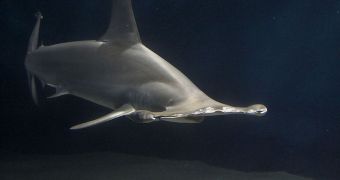For a long time, it seemed like the hammerhead sharks only existed to confuse scientists. Renowned around the world for the peculiar shape of their heads, these creatures have spawned heated controversies in international scientific circles, as evolutionary biologists and other experts tried to reach a conclusion on what made the animal develop such features. A number of explanations were set forth, but none of them managed to satisfy the majority of investigators. Now, 100 years later, it would appear that the answer to this mystery has finally been found, the BBC News reports.
The new report shows that the evolutionary trait gives the beasts the ability to sport an incredibly advanced binocular vision, similar to our own, while at the same time allowing it to see a full 360-degree panorama of everything around it. When stocking or hunting prey, this ability must certainly come in handy. Details of the new work, which was carried out by experts at the Florida Atlantic University (FAU), appear in the latest issue of the Journal of Experimental Biology. “Frontal vision in hammerhead sharks has been speculated about for decades but never tested,” explains Dr Michelle McComb, one of the FAU experts involved in the new research.
“This study confirmed that hammerhead sharks have anterior binocular vision,” the expert says. The group measured the fields of view of several shark species placed in tanks. They attached a number of sensors on the skin of the animals, which were aimed at recording the sharks' brain activity. Light beams were then shone on them from various locations, which allowed the scientists to figure out whether the sharks could see behind themselves or not. Hammerheads were proven to have excellent, 360-degree vision. “As the hammerhead head has expanded, the degree of binocular overlap has increased with it,” McComb says.
“I believed hammerheads would not have binocular vision, because their eyes were pointing out on the sides of the head. However, it turns out that the positioning of the eyes was really the key. This study has confirmed that vision may have played a role in the evolution of one of the ocean's most bizarre inhabitants. This has been a scientific question which has persisted since hammerheads were first described over 200 years ago,” McComb concludes.

 14 DAY TRIAL //
14 DAY TRIAL //